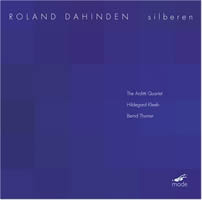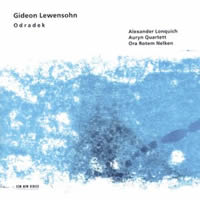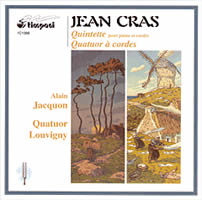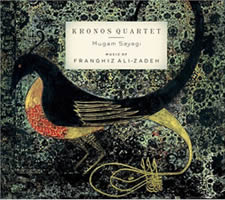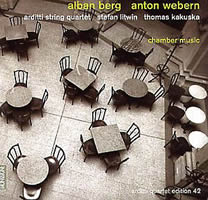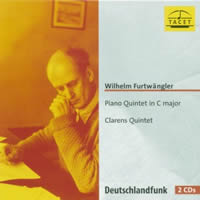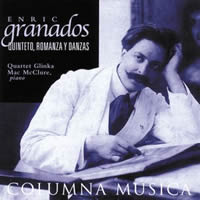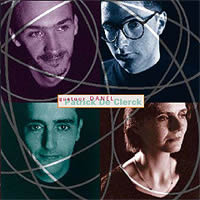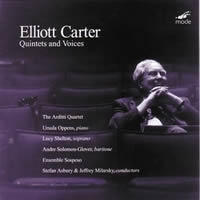Piano Quintets from Varied Lands
|
Grant Chu Covell [March 2005.] In the matter of standards, the Brahms F-minor Piano Quintet is my all-time favorite. Works by Dvorak, Elgar, Fauré and Feldman also occupy the list. Among the nine covered here, a few surprises and a few disappointments, with Cras, Lewensohn and De Clerck the big discoveries.
Roland DAHINDEN: silberen (1999); lichtweiss (1999). The Arditti Quartet: Irvine Arditti, Graeme Jennings (violins), Dov Scheindlin (viola), Rohan de Saram (cello); Hildegard Kleeb (piano); Bernd Thurner (vibraphone). mode 138 (http://www.mode.com/). In his piano quintet, Swiss composer / trombonist Dahinden echoes Richard Long’s sculptural stone arrangements. At 44:27, silberen’s 19 linked movements open like a late-Feldman ditty, but soon withdraw into a somnambulistic haze of lonely pitches and resigned gestures. Where Feldman may offer a pattern and then gently shake it, Dahinden’s continually altering material eventually resolves to the familiar. Imagine wandering aimlessly through a strange city, suddenly turning a corner and coming on to your starting point from a different angle. The opening piano sonority functions exactly like this, at one point beginning a sentence, elsewhere perched inside a lengthy soliloquy. The Ardittis reel out single notes which occasionally bond to form astringent chords. It’s hard to discern whether their steeliness is indifference or strict adherence to Dahinden’s wishes. Mutes and flautando unexpectedly mimic clarinet tones. The piano’s resonance contrasts with the strings’ minimal vibrato. Captured closely, some keyboard attacks strike harshly like an upturned hand. The Ardittis and pianist Kleeb — Dahinden’s wife — combine to create what must be a definitive performance, a deliberate effort to craft something vulnerable. Program notes refer to the work’s “whiteness.” I’m not sure this means Dahinden eschews sharps and flats, but the open spacing and contemplative pacing suggest a fog-wrapped Zen experience in keeping with Long’s artwork. A four-movement solo vibraphone piece from the same year, lichtweiss, completes the disc. As in silberen, the pace is slow, but the resonant steel bars enlivened by sticks and bows shine brightly.
Gideon LEWENSOHN: Piano Quintet (2000); Postlude (1992); Odradek Quartet (1999). Auryn Quartet: Matthias Lingenfelder, Jens Oppermann (violins), Stewart Eaton (viola), Andreas Arndt (cello); Alexander Lonquich (piano); Ora Rotem Nelken (piano). ECM 1781 (http://www.ecmrecords.com/). Set the booklet aside for a first listen: Lewensohn’s piano quintet brims with affable activity. Like the proverbial blue blanket this Jerusalemite’s music is reassuring and warm. Try sniffing out scents of other places and composers’ styles. In the enigmatically tapering Finale, you may catch the piano’s paper-thin quote from Shostakovich’s Fifth. It’s a bit like entering the reconstructed historic districts of towns smashed off the map in WWII, where the quaint façades front reinforced concrete, PVC pipes and satellite dishes. Strong magnets pull Lewensohn’s vocabulary towards an idealized prewar Europe, a world where Mahler is king, where ragtime and tangos are poised to take over the continent, where tribes seemed to co-exist. The five movements’ titles explicitly proclaim references and influences: Kurtág, the composer’s brother Micah, the Hilliards, Rochberg, and the aforementioned Dmitri. The Auryn Quartet joined with pianist Lonquich channel Mitteleuropa soirées without explicit quotations. Spindly motives lurch upwards only to deflate in sad-clown glissandi. You may think you’ve heard this shtick before, but Lewensohn is an excellent caricaturist with wry humor and showbiz timing. ECM captures the Auryn vividly. Compared to his ostensibly similar label-mate Silvestrov, Lewensohn’s life-affirming music shrouds different pains. The polystylistic string quartet Odradek, named after an inscrutable Kafka figure, could be called Bartók’s 5 ½ quartet. Fellow Israeli composer Josef Tal, Lutoslawski (the cello concerto’s somberly repeating D) and Giya Kancheli also appear. One of 17 mini-movements (Kurtág again) imagines Mahler and Kafka co-writing a musical while imprisoned in a Theresienstadt-like concentration camp. In Postlude — two different versions frame the quartet — a solo pianist meanders dreamily as if attempting to reconstruct a Mahler adagio from memory (pick a symphony, any symphony).
Jean CRAS: Quintette pour piano et cordes (1921-22); Quatuor à cordes (1909). Quatuor Louvigny: Philippe Koch, Fabian Perdichizzi (violins), Ilan Schneider (viola), Aleksandr Kramouchine (cello); Alain Jacquon (piano). Timpani 1C1066 (http://www.timpani-records.com/). Milhaud wrote string quartets on a train. Now meet French naval officer Jean Cras who composed at sea. Duparc had great praise for this autodidact. Cras stuck with the service while Roussel took to shore. Written while commanding a destroyer, the Amiral Sénès, Cras’ magnificent piano quintet explodes with a winsome vibrancy, exotic touches reflecting his fleet’s ports of call. Fauré provides models for the lavishly arpeggiated piano figurations, yet the cyclical motive-handling reflects Cras’ admiration for Schumann. According to the Commander’s program, the four movements reflect an ocean voyage: The outer two are expectant departure and triumphant return, the lush second and third reflect African and Arabian visits. Cras’ exotisme may be more romanticized than actual: In the African movement there’s a driving melody that sounds like Enescu or Khachaturian, and a sparkling pentatonic theme passes through the quintet’s upbeat finale. The earlier string quartet — labeled “No. 1, À ma Bretagne,” though a second never followed — plumbs a more severe channel (Cras was then a sub-lieutenant aboard the Léon Gambetta), its thicker textures reflecting Beethoven and Brahms. I definitely prefer the friskier piano quintet whose confident harmonies and irregular rhythms reveal a mastery of the genre and large forms. My meager seafaring confirms that Cras’ quintet captures an ocean voyage’s foam and spray. Other Cras compositions on Timpani include songs, piano works, orchestral works and a luscious opera, Polyphème (Timpani 3C3078).
Franghiz ALI-ZADEH: Apsheron Quintet (2001); Oasis (1998); Music for Piano (1989, 97); Mugam Sayagi (1993). Kronos Quartet: David Harrington, John Sherba (violins), Hank Dutt (viola), Jennifer Culp (cello); Franghiz Ali-Zadeh (piano). Nonesuch 79804-2 (http://www.nonesuch.com/). At her career’s start, Azerbaijani Ali-Zadeh pitched a tent in the European avant-garde. Her first compositions explored serialism. As a pianist, she was among the first to bring Cage, Crumb and Messiaen to the Soviet Union. Her vocabulary has since altered; she now looks to her birthplace for inspiration. Ali-Zadeh’s territory includes pre-recorded sounds, microtones, sensually slithering glissandi, muted strings, clusters and prepared piano (in Music for Piano she places a necklace on the strings), Azerbaijani scales, and a complex traditional genre called mugam. This disc showcases three Kronos Quartet commissions. The piano quintet — named for the peninsula near Azerbaijan’s capital — is two contrasting parts, “Tactile Time” and “Reverse Time,” the temporal aspects exhibiting an evaporative, dreamlike quality. The first movement passes like a speeding train through intricately layered scales and plaintive songs towards a controlled frenzy. In the second movement, Pärt-like scales moor expectant tremblings. Oasis and Mugam Sayagi are string quartets with tape. In Oasis water drips and voices murmur; drones and percussion lace Mugam Sayagi’s latter half. Listeners fond of the Kronos’ voracious and dispassionate playing will not be disappointed.
Anton WEBERN: Piano Quintet (1907, op. posth.); Vier Stücke für Geige und Klavier, Op. 7 (1910); Cello Sonata (1914, op. posth.); Drei Stücke für Violoncello und Klavier, Op. 11 (1914). Alban BERG: Neun kurze Stücke für Quartett, Sextett oder Violine und Klavier (1907-08, ed. Ulrich Krämer 1994). The Arditti Quartet: Irvine Arditti, David Alberman (violins), Garth Knox (viola), Rohan de Saram (cello); Thomas Kakuska (viola), Stefan Litwin (piano). Naïve Montaigne MO 782069 (http://www.naiveclassique.com/). The Ardittis are in top form in their eighth installment of Second Viennese School chamber music. Webern’s single-movement piano quintet, “Op. 0,” was created while studying with Schoenberg. At its premiere alongside other pupils’ works, a critic singled it out, bemoaning “the pernicious influence of Schoenberg’s compositions.” At 12 minutes it’s among Webern’s longest, bursting with Brahmsian ardor and extreme chromaticism. The opening viola melody is famously queasy. Hallucinatory sul ponticello signals structural points. Much preferable to the cursory reading tacked into Boulez’s recent Webern survey (six-disc DG 457 637-2 or the single DG 437 786-2), the Ardittis are astoundingly passionate and warm. The disc continues with spirited performances of Webern’s Opp. 7 and 11, and the 1914 cello sonata. Ulrich Krämer’s edition of Berg’s juvenilia adds 20 minutes. Schoenberg taught using classical models, and in Berg’s studies you can hear what the Ardittis would sound like if they were to play Schubert and Schumann. The disc finishes at 40:21! Perhaps they could have stretched the Second Viennese School umbrella to include Mahler’s apprentice 1876 piano quartet.
Wilhelm FURTWÄNGLER: Klavierquintett C-Dur (1912-34). Clarens Quintet: Gernot Süssmuth, Eva Schönweiss (violins), Felix Schwartz (viola), Andreas Greger (cello), Sebastian Krahnert (piano). Tacet 119 (http://www.tacet.de/). It’s impossible to strike up a casual acquaintance with Furtwängler’s overstuffed quintet. The three similarly-sized movements yield slowly, requiring patience and stamina from everyone. The concluding movement’s introduction is almost three listless minutes. The opening Molto Allegro’s passionate motives are introduced deliberately and it’s not until something lyrical appears do we realize that all that came before was the first theme group. The 80:22 opus is Brucknerian in scale, but harmonically closer to Brahms, Reger and Franck as seen through an idealized Romantic lens. In some transitional passages, chord progressions grind down to a standstill and every note seems unresolved and directionless. The esteemed conductor favors an all-or-nothing approach, so such leanness alternates with heady density, thick with pedal-down octave doublings. The quintet reveals a nascent symphonist. When off the podium, Furtwängler would eventually devote himself to orchestral works with varied palettes better suited to illuminate his bulky arguments. Tacet presents a live-wire recording, the in media res listener could be asked to turn pages. The Clarens’ commitment ought to leave lesser teams gasping. Curiously, other releases (Timpani 1C1018 and Bayer 100269) don’t straddle two discs, reining in the quintet at just over 66 and 73 minutes respectively.
Enrique GRANADOS: Quinteto, Op. 49 (1894, ed. Moises Bertran); seven assorted works collected as “Danzas & Romanzas.” Quartet Glinka: Ala Voronkova, Guerasim Voronkov (violins), Eric Koontz (viola), José Mor Caballero (cello); Mac McClure (piano). Columna Música 1CM0082 (http://www.columnamusica.com/). Columna Música introduces a new edition of Granados’ piano quintet based upon the original manuscripts. The initial publisher greatly disfigured the amiable three-movement work, truncating the first movement and altering harmonies. (On cpo 999 609-2, Ensemble Variable’s swagger can’t mask the abbreviated composition’s episodic nature.) The outer movements begin with catchy themes suggesting Dvorak — the “Dumky” Trio sprang immediately to mind. A delightful central movement bubbles with a folksy, bittersweet flavor. At its conclusion, the brisk finale restates the opening theme. Unfortunately, this is a flawed recording. The cello can be difficult to discern. The piano sounds out of tune in the second movement, at 3:08. Sometimes the acoustic will snap briefly into mono (third movement at 3:09). Granados, who perished when his ship was torpedoed on the last leg of a transatlantic voyage — he was returning from the acclaimed New York premiere of his opera Goyescas — deserves better. Several engaging dances and transcriptions round out the disc.
Patrick DE CLERCK: Pianokwintet (1993); A Stringtrio (1990); Sferen (1992); Già (1993). Quatuor Danel: Marc Danel, Gilles Millet (violins), Juliette Danel (viola), Guy Danel (cello); Jean-Marie Bardèche (piano). Megadisc MDC 7866 (http://www.megadisc.be/). De Clerck’s piano quintet is wonderfully disorienting. Its five sections suggest an arch, its boundaries appearing arbitrary as ideas and instruments coalesce and separate according to an indiscernible plan. A simple song in three-quarter time might appear, the viola will take a solo, or the pianist may hurl vigorous clusters at the piano’s extreme ends. This self-taught Belgian’s music has a particular naïve quality, as if composed in blind haste, without regard to preceding measures. Automatic writing comes to mind, yet the economical textures indicate a well-disciplined hand. Possibly the music transcribes some non-musical patterns, speech perhaps, or something occurring in the natural world. I admire the different pace, finding it intriguingly elusive even after several auditions. Spanning six movements, the gentle string quartet, Sferen, and the more aggressive string trio, A Stringtrio, frolic among similar qualities. The single-movement violin and piano duet, Già, spills forth like an amiable children’s song. De Clerck is the driving force behind Megadisc. Perhaps out of modesty, his music on his label is scant. Megadisc concentrates rather more abundantly on Goeyvaerts, Ustvolskaya, Silvestrov, and others from former Soviet states.
Elliott CARTER: Quintet for Piano and Strings (1997); Fragment II (1999); Syringa (1978); Tempo e Tempi (1998); Quintet for Piano and Winds (1991); Retrouvailles (2000). The Arditti Quartet: Irvine Arditti, Graeme Jennings (violins), Dov Scheindlin (viola), Rohan de Saram (cello); Ursula Oppens (piano); Lucy Shelton (sop.), Andre Solomon-Glover (bar.), Ensemble Sospeso, Jeffrey Milarsky, Stefan Asbury (conds.); Steve Taylor (oboe), Charles Neidich (clar.), William Purvis (horn), Frank Morelli (bsn.). mode 128 (http://www.mode.com/). Available as CD or DVD. Carter’s piano quintet bustles with five discordant voices that crisscross like fidgety, mutually oblivious, determined travelers in a cramped waiting-room. The Ardittis and Oppens’ assertive playing foists an impenetrable sheen over the single movement which should surprise no Carter fan. There is something right about the music’s angularity which on repetition reveals ambiguous questions and ambivalent answers. Mode’s DVD release adds Frank Scheffer’s arty film of the piano quintet in performance (discussed here) and a disjointed interview with Carter, Irvine Arditti (who looks like he’d rather be playing than talking), Oppens and Joshua Cody. Absent flute, the reedy quintet for piano and winds (oboe, clarinet, horn and bassoon) is tougher to penetrate, perhaps because the burnished hues combine in unfamiliar ways. Carter doesn’t suppress his fondness for the oboe (this and other oboe-prominent works having been commissioned by Heinz Holliger), yet there’s some rather extraordinary horn and bassoon writing — and playing — here, too. Syringa, with simultaneous Classical Greek and English (John Ashbery) settings, receives a superb performance. Tempo e Tempi could be considered the release’s third quintet. Its resonating acoustic contrasts with the other, drier venues. Solo piano Retrouvailles and Fragment II for string quartet are typical Carter trifles, which means they’d be complex multi-layered epics for other composers. The brief quartet is elegantly characteristic: individual lines progressing at different rates that briefly intersect before scurrying away. The Ardittis seem to relish the assignment.
[More Grant Chu Covell]
[Previous Article:
Marketing MTT -- What It's All About]
[Next Article:
The Orchestra of the S.E.M. Ensemble at Willow Place Auditorium]
|
